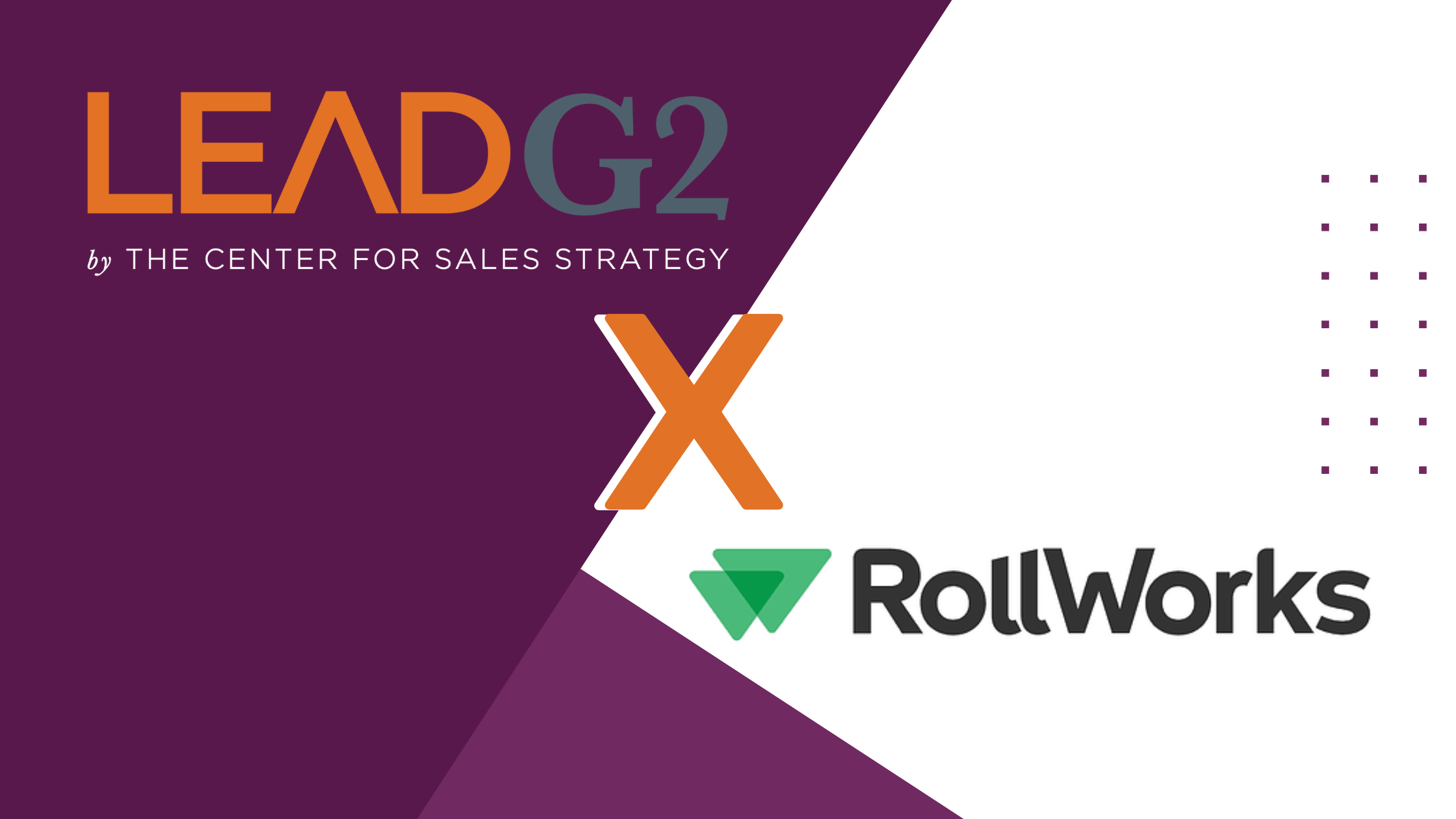.png)
.png?width=1600&height=900&name=SSSF-Podcast-EP29-Blog%20(1).png)
In this episode, we’re diving into Account-Based Marketing (or ABM), asking questions like: Why is ABM a strategy worth the consideration of sales leaders? What are the hurdles that leaders can anticipate when acclimating to an ABM strategy? And how do you determine what accounts to target in the first place?
Joining Dani to help break it all down is Elissa Nauful, Director of Sales at The Center for Sales Strategy. Elissa gets into some great points from her first-hand experience, like:
-
How it provides the perfect opportunity to build beautiful relationships with prospects
-
Why a strong ABM strategy requires alignment between sales and marketing, and how do that well
-
The role of technology in ABM
-
And, lastly, how ABM can paint such a clear picture of where people are in the buying process, making it that much easier to extend your “digital hand” and nurture them.
ABM Focuses on a Target Piece of Business and Doing Everything You Can to Win It
 “What do you love about ABM?” Dani asks, kicking off the conversation. “Why do you think others should possibly consider it?”
“What do you love about ABM?” Dani asks, kicking off the conversation. “Why do you think others should possibly consider it?”
“I think you'll probably hear this theme across all of my answers,” Elissa says. “Which is, you can take those businesses that you really want to win, that you've identified, that is the best target."
“We have access to the right person. We know we have solutions that fit what they need and you can nurture that relationship from the time you begin to market to them all through the sales process by almost kind of ‘super serving’ them.
“It's just a beautiful way to begin a relationship for a prospect. And I think that's a really smart way to spend your time and money.
“So, ABM is all about really focusing on a target piece of business and doing everything you can to win it.”
“Love it,” Dani says. “So, let's talk about what you've learned so far. I know that we're still learning a lot, but what do you think will be helpful to pass along to other sales leaders that are thinking about ABM? What are some of the key things that you've learned so far?”
Elissa says, “We have learned a lot.
“I think that we've made some mistakes, which is wonderful because you only learn through constant evaluation. So, I actually made some notes on some steps that if I was telling a director of sales. Here's some things that I'd look at.
“First of all, you really do need to evaluate your sales process.
“How are you handling every step in this sales process? That really starts with marketing. What is marketing doing at the top, middle, and bottom of the funnel to start to attract those potential buyers? What does the handoff look like between marketing and sales? How are you defining what a qualified lead is in marketing and in sales?
“And then, when that salesperson gets that warm marketing qualified lead, what's the expectation for them to take them through to the close?
“I think a lot of organizations say, ‘I'm going to sell’ or ‘I'm going to market,’ but they don't step by step put a plan together from the very beginning. And the very beginning isn't the minute they call you. The very beginning is the minute they're aware of you as a company or they think about you.
“I think that's really important. What does that outreach look like at every step? What's the expectation? And also, how are you going to hold your salespeople accountable to those steps to make sure they're following the process?
“Because how many times do you see a marketing director say, ‘well, I give sales qualified leads and they never come up with anything.’ And then on the other side, you see salespeople, sales managers say, ‘we never get qualified leads!’
“So, I think defining that process really reduces a lot of that friction.
“The second step is making sure your salespeople are using a CRM, they're documenting their process.
“So, as a sales manager, you can go in and see what the steps that they're taking. If they got a prospect or a lead, how are they following up? How are they communicating? Are they communicating in the cadence that you have the expectation for, for that sales process? I think that's important.
“The other opportunity is really to identify bottlenecks, right? If you have a salesperson that is great at getting a first appointment, but they can't seem to move to a close, that will give you a lot of intelligence around it.
“The other big thing I've learned is you need to make sure you have a really good target account list.
“I know we'll probably get into this later, but having a good target account list is crucial. And a target account list doesn't mean every person you ever wanted to do business with, which is one of the mistakes we made. You know, we want all the business.
“Well, you really need to be more focused and targeted in your list.”
“And then knowing how to communicate. What are you going to say? How are you going to say it? Make sure that the experience for the prospect is seamless and clean from the minute they get a marketing message all the way through to closing a piece of business.”
It's Important That There's Mutual Respect Between Sales and Marketing
“You touched on marketing and sales alignment a little bit in some of your tips just now,” Dani says. “But we know that it's always important, right?
“We're big believers of it. We teach it here at LeadG2, but what we've seen is that with ABM it's incredibly pertinent. So, tell us a little bit about your experience with marketing and sales alignment. What does that meant to you? What does that look like? And what do you just feel like has to kind of be in alignment to get this right?”
“I feel really lucky,” Elissa says. “Our director of marketing, we have the same goal. We really do want the same thing, which is she wants marketing to provide qualified leads to sales so we can win business. We're on the same page."
“We're also very transparent with each other. We have a lot of calls and had a lot of calls from the beginning about what was working, what wasn't working, and what our frustrations were. And we've had frustrations in this process. It hasn't been one where everything's great.
“We've really had some frustrations along the way with ‘How does this work?’ Or ‘Are we defining this the right way?’
“So, I really have appreciated the constant communication, but also how much we've critiqued each other on, you know, ‘How are you looking at this?’ ‘How am I looking at this?’
“We really do push each other, I think, to get better in a really positive environment. So, I think it's important that there's a mutual respect between sales and marketing.
“You have to make sure you're defining the important things. So don't look at vanity metrics. Sometimes you don't really know what you want to measure, but, let's be really clear, you don't have to measure everything. It does matter how many qualified leads come in and it does matter how many appointments you get and it does matter how much business is sold. Like that's why we're all here. Right?
“So, alignment is, frankly, about respect and communication and having a goal and then holding yourself accountable to it.”
Dani says, “Yes, and, you know, I think an important thing for folks listening to think about is that, often, we go into some big new strategy or plan or campaign or whatever it might be, and it's like, ‘okay, we we're going to get aligned, we're going to align marketing and sales for this.’
“And you're speaking to what I've seen as someone who has been part of this process, which is that we already had that alignment and that's what's really allowed us to be successful.
“So, if you're not already working to ensure that your head of marketing and your head of sales have a good working, transparent, healthy, relationship, then [adopting ABM] is going to be a little bit of uphill battle.
“I really recommend folks to get on that. Make that part of your culture and your process. Because it's only going to benefit you when you're doing new things like this.”
“Shaye, our Director of Marketing, and I report to the same person,” Elissa says. “And his goal is for us to be successful, and it's never a situation of ‘you are sales or marketing.’ We're never pitted against each other. We really do work as a team. We really do want the same thing. We really do want to work hard."
“I really do appreciate the fact that we can share when something great happens, but we can also share our frustrations."
“You just have to have a good working relationship but also be able to push back. Having a good working relationship doesn't mean you always agree. It just means that you work around the challenges.”
Challenges to Look Out for When Adopting an ABM Strategy
“What are some potential hurdles that sales and business leaders might encounter when adopting an ABM strategy?” Dani asks. “What have you come across and what do you think they should maybe plan for or anticipate?”
“It takes a lot of time,” Elissa says. “It takes a lot of time to understand what technology you want to use, how it's going to work with your CRM. What are you going to measure? Who's going to be responsible for what? So, almost an order of operations.
“And...we talk about this a lot, if you're trying to build the plane when you're flying it, it's going to take you twice as long.
“So, having good advisors, asking the right questions, having a process and plan in place is critical. Make sure that there's someone that's holding you accountable every week. So, ‘where are we this week? What are we looking at?’ Because it's easy to get overwhelmed and the data and the information or to go down a rabbit hole and chase the wrong thing.
“I really encourage everyone, before they start, to be really realistic about what their team's capabilities are.
“A lot of leaders think, ‘we can do it all,’ or ‘we don't need to pay the money to hire a company to do X, Y, Z because we can do it.’ And what happens is, you fast forward six months, and the team is burned out. They still aren't experts in it. They haven't really accomplished the goal they wanted to, and they've spent more money than they would've spent if they had hired an advisor or counselor or someone to do it. So, that's the key.
“The other thing, Matt Sunshine, who I report to, my boss, says, ‘you need to know your numbers. As a sales leader, you've got to know your numbers. You need to know what your average account is. You need to know what your business goal is, a financial goal for the accounts that you're going to go after.’ You need to know all of that so that when you're trying to budget for ABM you really know what the return on that is going to be.
“You've got to know what those numbers are so you can truly measure if it's working or not.”
“Yeah,” Dani says. “Love it. And I think what that all ties back to is having an expert either in-house or externally that is able to know the numbers, is able to expedite this process and ensure that you're not spending too much time trying to, like you said, ‘build the plane while you're flying it.’
“There are experts,” Elissa says. “It’s so much cheaper to hire someone who knows what they're doing than to try and learn it yourself.
“We always talk about, sort of, ‘do it with me or do it for me.’ And I think that if you have a partner that can really focus on the things they're good at so that your sales team can focus on selling and your marketing team can focus on attracting it, it just makes it so much easier.”
How to Determine What Accounts to Target & the Role of Tech in ABM
“So, we know that account-based marketing is all about those target accounts, right?” Dani says. “And I think some people forget that it's not mass media marketing; it's not casting the widest net. There's a time and a place for that kind of stuff.
“This is more about choosing high-quality accounts and targeting those folks in a very strategic way. So, tell us, how do you determine what accounts to target, and what does that process look like for you?”
Elissa says, “I always have a list of 25 dream companies to work with, right? And I determine those companies personally, and then I ask our team to do the same.
“They have to have the dollar fit, they have to be able to invest the amount of money that it costs for the solution that we're looking for. We have to have access to that person. We have to have done our research, we have to have a valid business proposition.
“We go through a good bit of criteria to determine initially who our target list is going to be and are they a good fit for our business? Based on all of that criteria, we narrow down a list.
“But the important thing with target lists is you can't have a huge list because your salespeople can't work 250 target accounts. It's a nice idea, but you want to really do a beautiful job of creating an experience for a prospect, you want to surprise and delight them.
“We want to create an experience in ABM where the prospect constantly sees value in communication and the connection that we're making with them to help them solve their biggest business challenges.
“That's our responsibility. Or that's at least what we see as our responsibility at CSS, LeadG2, and Up Your Culture. We want to solve that challenge. And that's not always one size fits all.
“So, customizing your approach based on the target and your solution makes the most sense.
“And we didn’t do that at first. But I think that was a wonderful lesson for us.
“Let's shift to technology because we are a RollWorks partner,” Dani says. “Tell us a little bit about your experience using RollWorks and the role that technology has played in ABM, especially for you.”
Elissa says, “I love RollWorks because of the HubSpot integration. And there is a learning curve, for sure. If you haven't used that integration before, you need to figure out what you're looking at, and how often you will look at the information.
“You can get a lot of vanity information where you notice that a huge company has come to your website once, and the natural salesperson in all of us wants to immediately call on every person in the organization because they came to your website. And that's not realistic, right?
“But the amount of intelligence that you can get from using a tool like RollWorks and really rolling it up effectively into HubSpot, I absolutely love.
“You can't do ABM without technology. You just can't. Or, you can, but it's a long, long play.
“We had challenges with some kinks in how to set things up and how to approach targeting and focusing on what keywords we wanted.
“But now that we're getting it under our belt, the amount of intelligence that we have to follow the prospects, the best prospects that we have, I think is compelling.
“I love the idea that we can market to them the way they need to be marketed to, in a way that hopefully isn't creepy, but is value based and what they're looking for.
The other thing is that there's data out there, right? So, it's just another reminder no matter what tool you use; you have to have a clean CRM. You need to get all the junk out of it. You need to make sure you're really paying attention to the data that you're putting in and that you're getting out.
And just like everything else, you've got to look at the right things. But technology's important. We've learned a lot from RollWorks.”
“I want to be clear,” Dani says. “One of the key pieces of data that we really are accessing is intent, right?”
“There's intent, but there's also the following of the journey stages, right?” Elissa answers. “So, a journey stage in RollWorks would be what we call in the deal stages, how an account is progressing through the sales process. Accounts progress through a marketing process but also a sales process.
“So, if you've targeted well, then the hope is that the marketing efforts are moving you closer to a sale.
“And the intent data is incredible too. You can get so much intelligence from that.
“There's a lot of data. The challenge sometimes can be, ‘there's a lot of data; what do you look at?’”
ABM Gives You a Broader Understanding of Where Prospects Are in the Buying Process
To wrap up the conversation, Dani asks, “What have you seen that maybe you didn't even expect with ABM? What have you seen that you've been kind of excited about?”
“I love seeing what people are consuming,” Elissa says. “What information are people really gravitating towards? That's incredibly helpful to me. We get a lot of insight into that.
“I'm also really interested in what people are searching for, and, sometimes, you think you're being very specific, and you find out that you're not. And so, just the terminology or the way people are searching for information is helpful.
“I think that one of the really important things with ABM is it really does give you a broader understanding of where prospects are in the buying process. Everyone's not ready to buy today. There is a reason why people don't call salespeople right away. They're doing all their homework online, right? And they're researching it.
“So, I think it gives us a much better understanding of how prospects are buying and what they're looking for and how to speak to them. It's really important to make sure that you're meeting buyers where they are.
“One of my colleagues says that you’re putting your digital hand out and taking them through the process, right? So, kind of nurturing them through the process. I think that’s really important.”

How to Build a Thought Leadership Strategy
After you’ve been in your area of business for a few years, you’ve got some experience under your belt, and you find yourself offering knowledge to...

B2B Marketing Tactics That Every Media Company Needs to Embrace in 2025
As we move further into 2025, the landscape of B2B marketing continues to evolve rapidly. Media companies must stay ahead of the curve to remain...
.png?width=2250&height=647&name=LeadG2-logo_(2).png)
 Brent Tripp
Brent Tripp



